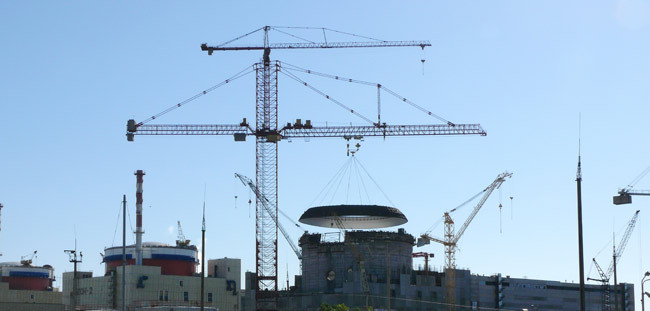
Tour of the construction site
back to contentsSpecialists of nuclear industry’s SROs are in a hurry: before the working day ends they will have to hold a meeting to discuss the upcoming inspection with the builders. “This is an integrated field inspection, Vladimir Shishkov, deputy technical director and head of industrial supervision at SRO, says. “We are interested in quality of construction and installation and conformance to standards.”
The SRO’s supervision department hires the best: each specialist graduated from a related university and is experienced in working at construction sites. At Rostov NPP the supervisors were faced by not only the paper work. They inspected piping welds in the turbine island, went up to the reactor dome and had debriefings each evening.
A monumental build
On the day of our arrival at the construction site it was foggy; Russian tricolor-painted buildings of two operating reactors were poorly seen through the veil. The nearly completed third reactor building is nearby. The future fourth reactor is a grey structure bound by white pipes, the guides, which will house metal ropes to be pre-stressed by special machines. The reactor pressure vessel in this garment is capable of withstanding an airplane crash and an 8 to 9-point earthquake, the builders claim.
A giant twin-tower mobile crane Kroll adds up to the site’s monumentality. The machine is designed to move loads of up to 240 tons in weight. There are just four such cranes across the world: one operated in Singapore harbor, one in Norway, the third in Ukraine at Khmelnitsky NPP and the fourth one moved to Rostov site after reactor commissioning at Kalinin plant.
“The turbine condensers of the first two reactors are cooled by water from the cooling pond, comments Vladimir Vorobiev, deputy chief engineer for quality assurance at the Volgodonsk-based branch of the prime construction contractor, NIAEP. “The new reactors will be cooled using cooling towers to avoid overheating of the pond.”
It drizzles; chilling wind tries to tear off the hard cap from the head. In spite of the weather, the construction goes on in full gear: trucks are horning; workers are carrying rebars, pipes, hand-barrows with concrete mix.
Unsealed reactor tests
The entrance to the containment that houses the reactor is at the symbolic elevation 36.6 meters. The room looks like a compartment of a huge spacecraft with thick-wall airlocks. The ceiling is like a dome; the dome perimeter is rail tracks where the polar crane moves. “During operation everything will be sealed,” Mikhail Pinchuk, chief engineer at Sezam constructor and installers’ branch in Volgodonsk, says.
Sezam’s specialists now have started another process operation, i.e. unsealed reactor tests where water goes to the reactor pressure vessel and flushes all the systems. “The operation will last till mid-April,” Rostov plant chief engineer Aleksey Zhukov says. At this stage, piping joints quality is tested; feed-and-bleed and emergency-and-scheduled cooldown systems are put on a trial run. These are tests of the primary equipment and piping cleaning to remove mechanical impurities like scale or sweepings. “We pour water in the ECCS accumulator tanks, pump in air and then open the valve, Mikhail Pinchuk explains. “Air displaces water under pressure.” A strong jet flushes the pipelines. “Water will be pumped out, and the reactor will be washed and wiped with alcohol, Pinchuk continues. “Then, the full-scale start-up program will start.” The tests will be followed by the reactor assembling. All reactor internals – baffle, barrel and protecting tube system – have been already delivered. Then, fuel assembly dummies will be put in and the reactor will be tested to open the way to put in real fuel and first criticality, which is slated for October 17.
All Rostov power units are built to the same design. “They are friendly to build, operate, repair; their spares are common, says Vladimir Voribiev, a NIAEP’s representative. “The sequence-flow construction is a convenient thing. You move from one facility to another.” Installers remember perfectly well deficiencies of the previous project that came up during construction of the initial two reactors and now they do away with such issues with no delay.
The Rostov site came up with several ways of expediting the process. For example, they “conveyor” cranes from one power unit to another. “We didn’t dismantle them, Oleg Snet, deputy director for production at NIAEP’s Volgodonsk-based branch, explains. “We moved them to the open space and then they travelled to the other power unit site by rail tracks.” This saved about six months for each crane on the master schedule.
Another know-how was to assembly the polar crane after the containment upper section’s skirt had been built. “We especially built the skirt with a hole and then passed the polar crane through it,” Snet says. “We were assembling the crane and concreting the skirt in parallel,” he adds. This operation saved four months net, he estimates.
This year, the Ministry of Energy of Russia expects over 9 MW of new capacities to be available. These include Beloyarsk-4 (over 800 MW), Rostov-3 (1,000 MW) and Novovoronezh Phase II’s Unit 1 (1,200 MW).




